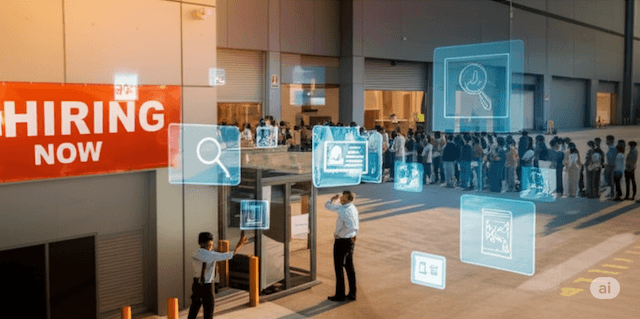Rajesh had been working at the fulfillment center for exactly 23 days when the theft was discovered. Missing: electronics worth ₹3.2 lakhs. The investigation revealed a sobering truth—his background verification was incomplete, his previous employer couldn't be contacted, and his reference turned out to be fake. In the rush to fill positions for the upcoming festive season, standard screening procedures had been "streamlined."
This scenario plays out hundreds of times across India's logistics sector every month.
India's logistics industry needs to create millions of new jobs to support its explosive growth. The warehousing sector alone is expanding at over 15% annually, while e-commerce fulfillment centers are opening faster than qualified workers can be found. This creates an impossible equation: massive hiring needs + limited talent pool + time pressure = compromised security.
The result? A perfect storm where India's greatest economic opportunity is also becoming its greatest security vulnerability.
The Numbers Game: Scale of the Challenge
The statistics paint a stark picture of the manpower crisis facing India's logistics sector:
Growth vs. Workforce Reality
- Market expansion: Logistics sector targeting ₹350 billion by 2030
- Job creation: Millions of new positions needed annually
- Skills gap: Only a small percentage of logistics workforce has formal training
- Attrition rates: Some companies report 40-60% annual turnover
- Geographic spread: Operations expanding to Tier 2 and Tier 3 cities with limited talent pools

The Security Implications
When companies face this level of hiring pressure, security standards inevitably suffer:
Rushed Recruitment
- Background checks that take weeks are compressed into days
- Reference verification becomes cursory or skipped entirely
- Employment history gaps are overlooked in favor of immediate availability
- Skills assessment takes precedence over character evaluation
Compromised Standards
- "Good enough" candidates become acceptable
- Red flags in applications are rationalized away
- Training periods are shortened to get people working faster
- Probationary periods become meaningless due to immediate operational needs
The Insider Threat Multiplier Effect
We've already explored how insider threats represent the biggest security risk to logistics operations. The manpower crisis doesn't just increase the volume of these threats—it exponentially amplifies their impact:
Quantity + Quality = Catastrophic Risk
More Potential Threats
- Larger workforce means more potential bad actors
- Rapid hiring increases the statistical probability of security risks
- Geographic expansion puts operations in areas with less established talent pools
- Seasonal hiring spikes create even more pressure for quick decisions
Lower Quality Screening
- Incomplete background verification misses criminal histories
- Fake references and documentation go undetected
- Employment gaps and inconsistencies are overlooked
- Financial stress indicators aren't properly assessed

The Compound Effect of High Attrition
High turnover rates create a vicious cycle that compounds security risks:
Constant Recruitment Pressure Every departing employee must be replaced quickly, often within days. This perpetual urgency makes thorough screening nearly impossible.
Lost Institutional Knowledge Experienced workers who understand security protocols leave, taking their knowledge with them. New hires start without the benefit of mentorship from security-conscious colleagues.
Training Shortcuts When 40-60% of your workforce turns over annually, comprehensive training becomes logistically challenging. Security training, often seen as secondary to operational training, gets cut first.
Cultural Erosion High turnover prevents the development of a strong security culture. Before security-conscious behaviors can take root, those employees are gone.
Regional Challenges: The Tier 2 and Tier 3 Reality
India's logistics expansion isn't just about scale—it's about geography. As operations expand beyond major metros into Tier 2 and Tier 3 cities, new challenges emerge:
Limited Talent Pools
Smaller Local Workforce
- Fewer experienced logistics professionals available
- Limited competition means settling for available candidates
- Less sophisticated recruitment infrastructure
- Reduced access to professional verification services
Different Risk Profiles
- Local crime patterns may not be well understood
- Regional economic conditions create different financial pressures
- Cultural differences in work practices and security awareness
- Limited law enforcement relationships and support
Infrastructure Limitations
Verification Challenges
- Slower internet connectivity hampers digital background checks
- Limited access to comprehensive databases
- Physical verification of references becomes more difficult
- Educational institution verification requires more manual processes
Training and Development
- Fewer training providers and programs available
- Limited access to professional development opportunities
- Less exposure to modern security practices and technologies
- Greater reliance on internal training capabilities
The Unorganized Sector Impact
A significant portion of India's logistics ecosystem remains unorganized, creating additional security vulnerabilities:
Compliance Gaps
Labor Law Adherence
- Inconsistent minimum wage compliance
- Irregular social security contributions (PF, ESI)
- Poor adherence to working hour regulations
- Inadequate worker safety and welfare measures
Documentation Standards
- Incomplete employment records
- Missing or falsified identity documentation
- Lack of standardized hiring procedures
- Poor record-keeping for tracking employee histories
[Reference data showing how unorganized players create compliance and security challenges]
Ripple Effects on Organized Players
Competitive Pressure Organized companies face pressure to match the lower costs of unorganized players, sometimes leading to corners being cut in screening and verification.
Talent Migration Workers move between organized and unorganized sectors, bringing with them inconsistent security awareness and practices.
Supply Chain Vulnerabilities Even security-conscious companies can be exposed through partnerships with less rigorous operators in their supply chain.
Technology Solutions: Scaling Security with Growth
While the manpower crisis creates security challenges, technology offers solutions that can scale with growth:
Digital Verification Platforms
Automated Background Checks
- Criminal record verification across multiple databases
- Employment history validation with digital verification systems
- Educational qualification confirmation through online platforms
- Real-time reference checking via digital communication tools
AI-Enhanced Screening
- Document authenticity verification using machine learning
- Pattern recognition for identifying fraudulent applications
- Risk scoring algorithms to prioritize candidates for manual review
- Behavioral assessment through digital interview platforms

Continuous Monitoring Systems
Ongoing Verification
- Regular database updates for existing employees
- Social media monitoring where legally permissible
- Financial stress indicators through third-party services
- Performance correlation with security incidents
Behavioral Analytics
- Access pattern analysis identifying unusual behavior
- Productivity correlation linking performance changes to potential risks
- Peer feedback systems for early warning signs
- Automated alert systems for policy violations
Building Scalable Security Culture
Technology alone isn't enough. Creating a security-conscious culture that can scale with rapid growth requires systematic approaches:
Structured Onboarding Programs
Security-First Orientation Every new hire, regardless of position, should receive comprehensive security training that covers:
- Company security policies and their importance
- Personal responsibility for maintaining security
- Reporting mechanisms for security concerns
- Consequences of security violations
Mentorship Systems
- Buddy programs pairing new hires with security-conscious employees
- Regular check-ins during probationary periods
- Gradual responsibility increase based on demonstrated reliability
- Performance feedback that includes security considerations
Incentive Alignment
Positive Reinforcement
- Recognition programs for security compliance
- Performance bonuses that include security metrics
- Career advancement tied to security awareness
- Team competitions around security goals
Clear Consequences
- Transparent disciplinary policies for security violations
- Consistent enforcement regardless of employee level
- Progressive discipline that educates rather than just punishes
- Fair process that maintains trust while enforcing standards

Strategic Workforce Planning: Getting Ahead of the Crisis
Forward-thinking companies are implementing strategic approaches to workforce planning that address both growth needs and security requirements:
Proactive Talent Development
Skills Development Programs
- Internal training academies developing logistics professionals from entry level
- Partnerships with educational institutions creating talent pipelines
- Certification programs that include security components
- Cross-training initiatives building versatile, security-aware employees
Retention Strategies
- Competitive compensation packages reducing financial stress
- Career development paths providing advancement opportunities
- Work-life balance improving job satisfaction
- Employee engagement building loyalty and commitment
Geographic Strategy
Hub-and-Spoke Talent Model
- Regional training centers developing local talent
- Talent mobility programs moving experienced workers to new locations
- Local partnership strategies working with regional recruitment agencies
- Community engagement building relationships in new markets
The Business Case: Why Security-Conscious Hiring Pays
While thorough screening and security-conscious hiring may seem expensive and time-consuming, the business case is compelling:
Direct Cost Avoidance
Theft Prevention
- Each prevented theft incident saves direct losses plus investigation costs
- Reduced insurance claims maintain better premium rates
- Avoided operational disruptions maintain productivity levels
Reduced Turnover
- Better hiring decisions lead to longer employee tenure
- Reduced recruitment and training costs
- Maintained operational knowledge and efficiency
Competitive Advantages
Client Confidence
- Demonstrated security consciousness attracts premium clients
- Reduced incidents support higher service pricing
- Enhanced reputation enables business expansion
Operational Excellence
- Security-conscious employees tend to be more conscientious overall
- Better adherence to all policies and procedures
- Improved safety records and compliance scores
Real-World Success: Companies Getting It Right
Case Study: Regional 3PL Provider's Transformation
A major Third-Party Logistics provider operating across 12 Indian cities faced severe security challenges due to rapid expansion:
The Challenge:
- Opening 5 new facilities in 6 months
- Hiring 2,000+ employees across Tier 2 cities
- Multiple theft incidents during initial operations
- Client complaints about security standards
The Solution:
- Standardized digital verification platform across all locations
- Regional training centers providing consistent security education
- Technology-enabled monitoring of all new hires during probation
- Incentive programs rewarding security compliance
Results After 12 Months:
- 65% reduction in security incidents
- 30% improvement in employee retention
- ₹1.8 crore savings in theft prevention and reduced turnover costs
- 15% increase in client satisfaction scores
Case Study: E-Commerce Giant's Seasonal Strategy
A major e-commerce company developed innovative approaches to seasonal hiring challenges:
Seasonal Hiring Innovation:
- Pre-verified talent pools maintained year-round
- Graduated access systems limiting new hire privileges
- Intensive monitoring during peak season periods
- Performance-based permanent hiring from seasonal workforce
Security Integration:
- AI-powered candidate screening identifying high-risk profiles
- Real-time monitoring of all seasonal employees
- Mentorship programs pairing seasonal workers with permanent staff
- Rapid response protocols for security incidents
Peak Season Results:
- Zero major theft incidents during festive season hiring surge
- 40% of seasonal workers offered permanent positions
- Improved operational efficiency despite 300% workforce increase
- Enhanced client trust leading to increased business volume
Implementation Framework: Your Security-Conscious Hiring Strategy
Phase 1: Foundation Building (30-60 Days)
Current State Assessment
- Audit existing hiring processes identifying security gaps
- Analyze historical security incidents correlating with hiring patterns
- Evaluate current verification procedures against best practices
- Assess technology capabilities for enhanced screening
Policy Development
- Create comprehensive hiring standards that prioritize security
- Develop verification procedures appropriate for different risk levels
- Establish clear consequences for circumventing security processes
- Design training programs that embed security consciousness
Phase 2: Technology Implementation (2-4 Months)
Digital Verification Systems
- Deploy automated background check platforms
- Integrate AI-enhanced document verification
- Implement continuous monitoring systems
- Create centralized candidate databases
Training Infrastructure
- Develop online security training modules
- Create assessment tools for security knowledge
- Build mentorship program frameworks
- Establish performance tracking systems
Phase 3: Cultural Integration (3-12 Months)
Culture Development
- Launch recognition programs for security compliance
- Implement feedback systems for continuous improvement
- Create communication channels for security concerns
- Build leadership commitment to security-first hiring
Continuous Improvement
- Monitor security metrics correlation with hiring practices
- Gather employee feedback on security training effectiveness
- Refine processes based on operational experience
- Scale successful practices across all locations
The Choice: Lead or Follow
India's logistics sector stands at a critical juncture. The companies that solve the manpower-security equation will dominate the market. Those that don't will struggle with operational disruptions, escalating costs, and damaged reputations.
The winners will be companies that:
- Invest early in security-conscious hiring practices
- Leverage technology to scale verification and monitoring
- Build cultures that prioritize security alongside productivity
- Plan strategically for sustainable growth rather than just rapid expansion
The losers will be those that:
- Compromise security for short-term hiring needs
- Ignore technology solutions that enable scalable security
- Accept high turnover as an inevitable cost of doing business
- React to incidents rather than preventing them proactively
Your Next Steps: Building a Security-Conscious Workforce
The manpower crisis in India's logistics sector is real, but it's not insurmountable. Companies that take a strategic, technology-enabled approach to hiring can turn this challenge into a competitive advantage.
The key is recognizing that security-conscious hiring isn't just about preventing theft—it's about building the foundation for sustainable, profitable growth.
Ready to transform your approach to workforce security? Our comprehensive analysis includes detailed frameworks for security-conscious hiring, technology evaluation guides, and proven strategies for building scalable security cultures.
Download the Complete Workforce Security Guide →
Access detailed hiring frameworks, technology vendor evaluations, training program templates, and ROI calculation tools for security-conscious workforce development.
Need help developing a security-conscious hiring strategy for your operations? Our workforce security experts can assess your current practices and develop customized solutions for your specific challenges.
Schedule a Workforce Security Consultation →
Related Reading in This Series
- Why India's Booming Logistics Sector Faces a Security Crisis: Understanding the broader security landscape
- The Hidden Enemy: Insider Threats in Indian Logistics: Preventing internal security risks
- From Reactive to Proactive: AI Revolution in Warehouse Security: Technology solutions for modern security challenges
- Coming Next: Specialized security approaches for different logistics segments
Tags: #LogisticsManpower #WorkforceSecurity #EmployeeVerification #HiringChallenges #LogisticsWorkforce #SecurityHiring





